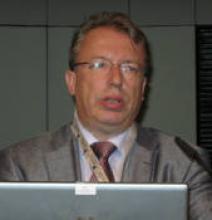MADRID - Sunscreens alone are not sufficient to prevent the development of melanocytic nevi in children, with consequent increased risk for melanoma later in life, results of numerous studies indicate.
"Sun avoidance and clothing are required for primary prevention in children," Dr. Claus Garbe stressed at the 13th World Congress on Cancers of the Skin. This concept is not yet understood by the public at large.
"The public supposes that by using sunscreens regularly they protect themselves from cancer, but it's a very poor quality protection," said Dr. Garbe, professor of dermatology and head of the division of dermato-oncology at Eberhard Karls University, Tübingen, Germany.
At least half a dozen studies dating back to the early 1990s have established that the most important risk factor for melanoma is a person's total number of melanocytic nevi. With growing numbers of melanocytic nevi the melanoma risk increases almost linearly. Another independent risk factor is the presence of atypical nevi. These risk factors are multiplicative, such that individuals with more than 100 melanocytic nevi and at least 5 atypical nevi are at close to 50-fold increased risk for melanoma.
"The message of these investigations is we are able to identify easily patients who are at elevated risk for melanoma development. That's the case for about 5% of the Caucasian population. These are the persons we should have in a serial examination program for early melanoma detection," he said at the meeting sponsored by the Skin Cancer Foundation.
In a cross-sectional study of 1,812 German children aged 2-7 years and their parents, Dr. Garbe and coworkers found that the melanocytic nevi counts increased from a median of 2 at age 2 years to 20 at age 7.
Nevi counts were strongly related to the number of weeks spent on holidays in sunny climes, the amount of time spent in summer outdoor activities without sunburns, facial freckling, skin type, parental ethnicity, and the number of parental moles - but not to previous sunburns (Cancer 2003;97:628-38).
In a subsequent analysis, the investigators found no significant protective effect for sunscreen use on melanocytic nevi counts, whereas a regular practice of wearing clothing at the beach or pool was inversely associated with the number of melanocytic nevi (Am. J. Epidemiol. 2005;161:620-7).
Next came a longitudinal interventional study in which Dr. Garbe and coinvestigators randomized 1,232 young German children in two cities to one of three study arms, each lasting 3 years: parental educational sessions three times per year on the importance of sun protection; parental education plus free broad-spectrum SPF 25 sunscreen; or a control group in which parents were informed of the importance of sun protection measures for their children only at an initial meeting. Sunscreen use proved to have no impact on the increase in melanocytic nevi counts over time, which was similar in all three groups (Int. J. Cancer 2005;116:755-61).
Australian investigators have also found that regular use of sunscreen was not associated with the number of melanocytic nevi in an observational study involving 1,623 children (Cancer Epidemiol. Biomarkers Prev. 2005;14:2873-6).
The key factor related to the number of melanocytic nevi was the amount of time spent outdoors between 11 a.m. and 2 p.m. Children whose backs were covered by clothing less than 70% of the time they were outdoors had 53% more nevi than those whose backs were always covered.
This finding, coupled with the German studies, led to the ongoing North Queensland Sun-Safe Clothing Study, in which 652 Caucasian Aussie children up to age 3 years were randomized to parental education plus free UV-protective beach suits for the children or to usual care.
At baseline the investigators didn't find a significant relationship between reported use of sunscreen and melanocytic nevi counts (Am. J. Epidemiol. 2005;161:536-45). Long-term follow-up results with the number of new melanocytic nevi as primary endpoint are due soon, and Dr. Garbe anticipates a positive result.
Asked why sunscreen usage doesn't prevent melanocytic nevi, he replied the main reason is that sunscreens are far less efficient than their measured SPF rating would suggest.
"The SPF is measured using 2 mg of sunscreen per square centimeter of body surface," he explained. "That would mean that with a roughly 1.5m2 body surface, after subtracting the hairy parts, we would need 30 g for a one-time use of sunscreen, which is one tube. Nobody does this. And the SPF decreases in logarithmic fashion, so if you use 7.5g of a sunscreen with an SPF of 30-50, you only have an SPF of 3-4."


